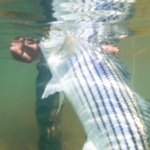
Veteran Florida Guides Concerned About False Albacore
While the ASGA team is extremely proud of the community we’re building with the Guide
By Tony Friedrich, Vice President/Policy Director
We know it has been a while since we’ve talked about striped bass. But the Atlantic States Marine Fisheries Commission’s (ASMFC’s) Striped Bass Board will be convening virtually tomorrow (Tuesday, August 3) from 9am-12:30pm to discuss—among other things—progress on Amendment 7, and we want to give folks a sense of what to expect.
The Striped Bass Plan Development Team (PDT) and the Technical Committee (TC) met several times in June and July to discuss Amendment 7 in relation to the guidance given by the Board at the May meeting.
As a quick refresher, in May the following items, initially included in the Public Information Document for Amendment 7, were removed from consideration: Goals and Objectives; Recreational Accountability; Biological Reference Points, Rebuilding Timelines (although an additional provision was added to protect the 2015 year class), and Regional Management. We had advocated for each of these to be taken out of the formal amendment. Commercial Allocation was also removed but will be addressed in a standalone measure. Recreational accountability is something we firmly support. Much like commercial allocation, it is better handled as a standalone issue. All in all, this was a big win for the good guys.
What’s Left?
What is still on the table? The discussion at the August meeting will focus on the items that remain in the amendment: Recreational Release Mortality, Conservation Equivalency; and Management Triggers. Where are the pitfalls? What should we expect from this discussion?
Let’s break each of these down. The PDT and the TC are going to need some guidance from the Striped Bass Management Board on the following issues/questions, copied below from a July 19 memorandum (beginning on p. 118) from the PDT to the Board in advance of the meeting.
Recreational Release Mortality:
What types of effort control options should be included in the Draft Amendment?
The memo’s final paragraph discussing recreational release mortality, which focuses on potential development of no-harvest or no-targeting closures, summarizes the challenge quite well:
“The most appropriate approach may depend on the reason for the closure; for example, implementing a no-targeting closure during high temperature periods when release mortality rates are increased. Various scenarios and assumptions can be explored with MRIP effort data, likely with high PSEs, but factors like changes in angler behavior are unpredictable and catch-and-release trips are not separable in MRIP.”
We believe in doing the best we can with the tools that we have. Let’s face it, 9% release mortality across the board is not a terrible number. The statement above suggests that information ASMFC is using when it comes to factoring in angler behavior for closures is limited. This is disappointing because there is some excellent research out there examining human dimensions of the striped bass fishery.
Is it a non-targeting closure or just a non-harvest closure? This is important because MRIP data does not separate catch and release trips from harvest trips. Would anglers fish for something else? Then, in areas like the Chesapeake, you can certainly target another species during a non-target closure but that does not mean that you won’t encounter striped bass. So, how effective will these closures be? Will closures be used properly or just to allow for unsustainable harvest during the open season? Please remember that all of this effort is going on while Massachusetts DMF is conducting a very extensive study on catch-and-release mortality.
Let’s move onto a constant bugaboo in striped bass management: Conservation Equivalency (CE). Again, from the memo:
Conservation Equivalency
Is the Board willing to specify now which sector(s) of the fishery would be subject to new restrictions on the use of CE?
“From the PDT’s perspective, the other front-end measures being developed for CE proposals (e.g., restrictions on when CE can be used, requiring an uncertainty buffer, setting data standards) are a more effective tool to improve the performance of CE in the striped bass fishery. Ultimately, the PDT recommends the removal of CE accountability options from Draft Amendment 7. For the same reasons, the PDT also does not consider a CE performance analysis as requested by the Board to be feasible at this time.”
The “front end” measures could be something like the option Commissioner White (NH) discussed at the meeting in May. He suggested that if a state opts for CE, then they should have to be held to a higher standard than just a 50% probability of success. ASGA firmly believes that CE should not be allowed while striped bass are overfished. We also must contend with data limitations for state level closures that may have PSE’s exceeding 50%. This is going to be a complicated issue. We will be watching this very closely and do our best to distill it down once the options are available.
Regarding Management Triggers, the memo asks of the Board:
Management Triggers
The management trigger issue is certainly more cut-and-dry than recreational mortality and conservation equivalency. We must be vigilant though. It is the one place that actions could undercut our conservation work most significantly. A simple change of words could have negative consequences by limiting the ability of managers to act quickly to address stock concerns.
This is the outline for the Amendment 7 discussion at the meeting. Please understand that public comment will be needed again after the October meeting when the draft amendment will be ready. It is up to all of us to engage on this issue. We won a big victory in May and can certainly do it again. Please look out for our upcoming meeting report for guidance on next steps.

While the ASGA team is extremely proud of the community we’re building with the Guide

Feature Image: A false albacore being landed off Jupiter Florida by the Cheeky Fishing team,

Feature Photo: “Best Practices for Fishing Cobia Around Manta Rays” The Florida Manta Project is

We caught this article a few days ago. Here’s the summary: Maryland striped bass commercial
We rely on our members and donations to keep fighting for a sustainable tomorrow in marine conservation.
By using this website, you agree to our use of cookies. We use cookies to provide you with a great experience and to help our website run effectively. To learn more, please review our privacy policy.
2 Responses
Also at this meeting, the Striped Bass Management Board reviewed the progress being made on Amendment 7 and the performance of the 2020 fishery. Amendment 7 has also been resolved in most areas, which we are happy about.